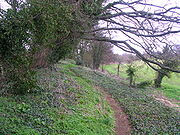
Deddington Castle
Encyclopedia

Deddington
Deddington is a civil parish in Oxfordshire about south of Banbury. In scale Deddington is a village, but it has a town centre with a market place and the local football team is called Deddington Town FC.-History:...
6 miles south of Banbury
Banbury
Banbury is a market town and civil parish on the River Cherwell in the Cherwell District of Oxfordshire. It is northwest of London, southeast of Birmingham, south of Coventry and north northwest of the county town of Oxford...
, Oxfordshire
Oxfordshire
Oxfordshire is a county in the South East region of England, bordering on Warwickshire and Northamptonshire , Buckinghamshire , Berkshire , Wiltshire and Gloucestershire ....
.
It was built on a Saxon
History of Anglo-Saxon England
Anglo-Saxon England refers to the period of the history of that part of Britain, that became known as England, lasting from the end of Roman occupation and establishment of Anglo-Saxon kingdoms in the 5th century until the Norman conquest of England in 1066 by William the Conqueror...
site as a motte and bailey castle in the 11th century by Bishop Odo of Bayeux, the half brother of William the Conqueror. William de Chesney, Lord of Deddington, held the castle in the mid 12th century but in the late twelfth century it was seized by the Crown during the struggle between King Richard
Richard I of England
Richard I was King of England from 6 July 1189 until his death. He also ruled as Duke of Normandy, Duke of Aquitaine, Duke of Gascony, Lord of Cyprus, Count of Anjou, Count of Maine, Count of Nantes, and Overlord of Brittany at various times during the same period...
and his brother Prince John
John of England
John , also known as John Lackland , was King of England from 6 April 1199 until his death...
. By this time the outer bailey was defended by a gatehouse and curtain wall and the Norman
Normans
The Normans were the people who gave their name to Normandy, a region in northern France. They were descended from Norse Viking conquerors of the territory and the native population of Frankish and Gallo-Roman stock...
motte had been levelled to make room for a range of buildings. Descendants of the Chesneys, the Dive family, regained possession of the castle in the thirteenth century but by the end of that century it was partially demolished and by 1310 there seems to have been little left. The site of the castle, together with its park and meadows, was sold to the canon
Canon (priest)
A canon is a priest or minister who is a member of certain bodies of the Christian clergy subject to an ecclesiastical rule ....
s of Windsor
Windsor, Berkshire
Windsor is an affluent suburban town and unparished area in the Royal Borough of Windsor and Maidenhead in Berkshire, England. It is widely known as the site of Windsor Castle, one of the official residences of the British Royal Family....
in 1364.
Now only earthworks remain and it is administered by English Heritage
English Heritage
English Heritage . is an executive non-departmental public body of the British Government sponsored by the Department for Culture, Media and Sport...
.
Excavations in 1949 and 1978 revealed castle foundations in good condition.

